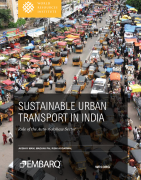Sustainable Urban Transport in India
Role of the Auto-rickshaw Sector
by , and -This paper examines the role the auto-rickshaw sector can play in promoting sustainable urban transport in India. It develops a policy vision for this sector and presents recommendations on reforms to address sustainability challenges.
Key Findings
Executive Summary
Study Objective and Approach
As the demand for urban transport increases in India, so too does the popularity of the autorickshaw. Production of this type of motorized three-wheeler has doubled between 2003 and 2010. In major Indian cities, it is responsible for a significant share of motorized trips. Strategies to improve urban transport must include a policy vision for this increasingly important sector. To that end, this paper examines the role the auto-rickshaw sector can play in promoting sustainable urban transport in India. It develops a policy vision for this sector and presents recommendations on reforms to address sustainability challenges.
The Avoid-Shift-Improve (ASI) framework, one of the key approaches to promote sustainable urban transport, is the basis of this study. The ASI framework is based on three key strategies: (1) avoid unnecessary trips, (2) shift to more sustainable transport modes, and (3) improve performance in all modes (Dalkmann and Brannigan 2007). In assessing the role of the auto-rickshaw sector in promoting sustainable urban transport, this paper looks specifically at how auto-rickshaws can contribute to Shift and Improve strategies, using a two-pronged approach:
Examination of the role of the type of service (contract carriage) provided by auto-rickshaws in promoting sustainable urban transport, as part of the Shift strategy;
Assessment of the need for improvements in the type of vehicle (motorized three-wheeler) in the auto-rickshaw sector to promote sustainable urban transport, as part of the Improve strategy.


